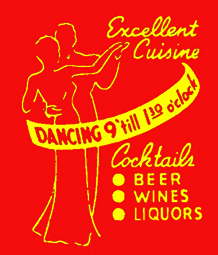 |
LIVE !
FROM
C LUB KAVAKOS!
|
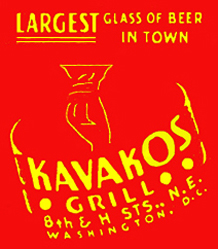 |
|
|
|
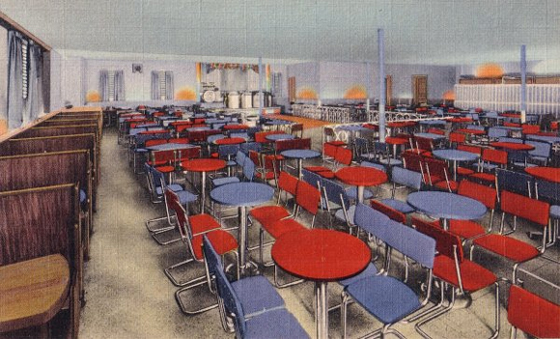
Facing the Bandstand, Circa 1941
Although postcard printers' airbrushes often idealize their subjects, the Kavakos' luncheonette-style decor lacks the seedy look of most nightclubs with their lights up.
Courtesy Don Thompson, http://www.norVApics.com
|
To 1950s' Washington, Club Kavakos was a long cab ride from the fashionable "downtown" nightclub district. Yet the Kavakos, which closed in 1955, has left one of the most enduring legacies of any local nightclub. That legacy is aural.
The Kavakos, a family-run bar and grill, was located at 727 H Street NE, home of the popular Beuchert Tavern for much of the 19th Century. Opening just after Prohibition, it presented a mix of music, such vaudeville flotsam and jetsom as ballroom dance teams, and "peelers", the imitation Walter Winchells' term for strippers. Later the Kavakos was a popular place for servicemen and women to spend a wartime evening over a few cold Heurich's.
On Sundays in the 1950s, the Kavakos hosted a band which self- importantly labeled itself "The Orchestra". Led by a drummer with the wonderful stage name "Joe Timer", The Orchestra was composed of local jazz heroes and journeymen from lesser touring bands.
|
|
|
Washington pianist, bandleader, arranger, and recording engineer Bill Potts has recalled that The Orchestra attracted crowds after Redskins games, as Club Kavakos was just a straight shot down Florida Avenue and short dogleg across 8th Street from Griffith Stadium.
On Sunday afternoons during the 1952 season, the fans had serious need for postgame consolation. Young quarterback "Little Eddie" LeBaron steadily proved he was not a worthy heir to struggling Sammy Baugh as the Redskins lost 5 of 6 home games. But after the season ended, the action at Club Kavakos perhaps slowed considerably.
|
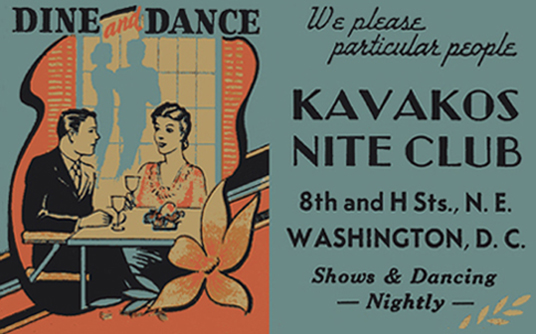 |
|
|
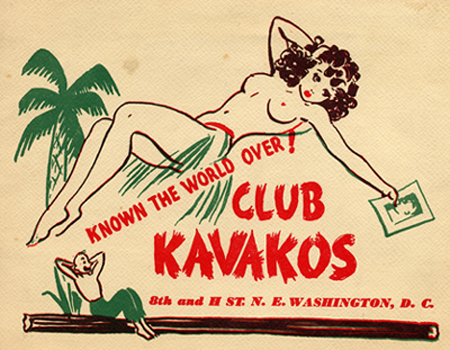
Wartime Washington was a city of instant friendships as ephemeral as a nightclub photograph. Share a Heurich's with Ralph, Bill, and their friend the WAC private by clicking here.
|
Perhaps it was a need to invigorate the act that led the Kavakos' owners to hire a jazz superstar to sit in with The Orchestra. On Sunday, February 22, 1953. Charlie "Bird" Parker arrived at the club without his sax, and In Potts' recollection, had to borrow a clear plastic practice model to play the gig.
Parker, with just two years to live, was in the downhill phase of his career. However his Kavakos performance has a raw vibrancy that has kept the 9 tracks Potts recorded in print for decades on both LP and CD. Although The Orchestra was the local all-star team, it stays largely in the background and allows Parker plenty of solo space. Reviewers generally describe its performance with adjectives like "workmanlike".
Apparently the Parker experiment was successful enough to be repeated. On April 5, 1953, the Bud Powell Trio with Charles Mingus recorded 11 songs and an interview with its leader. This performance has long been in print under the title "Inner Fires". And on March 13, 1955, Dizzy Gillespie recorded a dozen-odd tracks with backing by The Orchestra, whose work was described as "fine (if not distinctive)" by one reviewer. The session, which included an Orchestra original arranged by Timer, appeared on both LP and CD under the title "One Night In Washington" and is considered a significant Gillespie recording.
|
|
|
Shortly after the Gillespie session, the Kavakos closed. Soon afterwards The Orchestra disbanded following the death of Joe Timer. H Street NE itself spiriled downwards economically and bumped along the bottom through decades of deterioration. Arson permanently scarred the street during the April, 1968 rioting, but many would feel that the neighborhood's low point came with the gang-rape and murder of Catherine Fuller in 1984. This killing in an alley just around the corner from the Club Kavakos building defined a period in Washington's history in the same way that the Central Park jogger case did for New York.
It was not until the late 1990s that the H Street NE commercial district began to revive in fits and starts, amid much controversy. Ironically, the Club Kavakos' Victorian building became a casualty of the revival when it was demolished to construct new retail space in 1999.
|
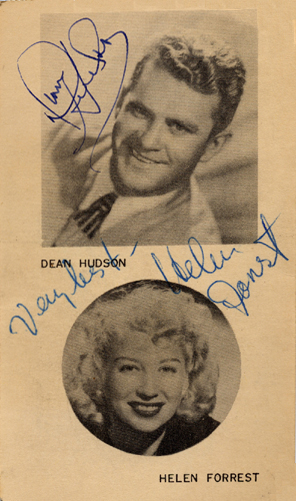 |
|
As this 1950's promotional postcard suggests, most Club Kavakos headliners were not as hip as the gods of bebop.
Helen Forrest was "discovered" by Artie Shaw while performing at Washington's Madrillon Club in 1938. She sung with Shaw and Benny Goodman before recording "I Had the Craziest Dream", a wartime ballad megahit with the Harry James Orchestra. She played the nightclub circuit for perhaps 40 years after the Big Band era ended.
Photo and autograph to the contrary, "Dean Hudson" did not exist. The "Dean Hudson" persona was invented for the frontman of a depression-era collegiate orchestra, and was played by several musicians over the band's long professional career as a second eschalon purveyor of "sweet" dance music.
|
|
|
|
To step into a Washington midnight in February 1945, click here.
To witness "The Fall of Club Kavakos", click here.
To read Eddie Dean's fine City Paper interview with Bill Potts, click here.
For a discography of his Club Kavakos session, click the musician name below:
Parker Powell Gillespie
Joe Timer led an ill-starred life,soit is fitting that the only known recording of The Orchestra away from the Club Kavakos occupies a few tracks on a CD not generally available outside Japan. Click here for information about this recording from the "Willis Conover's House of Sounds" radio show.
|
|
|
To view our "Billie Holiday In Washington, DC" page, click here.
To return to "Where Old DC Drank", click here.
To return to the Victorian Secrets homepage, click here.
|
|
|





